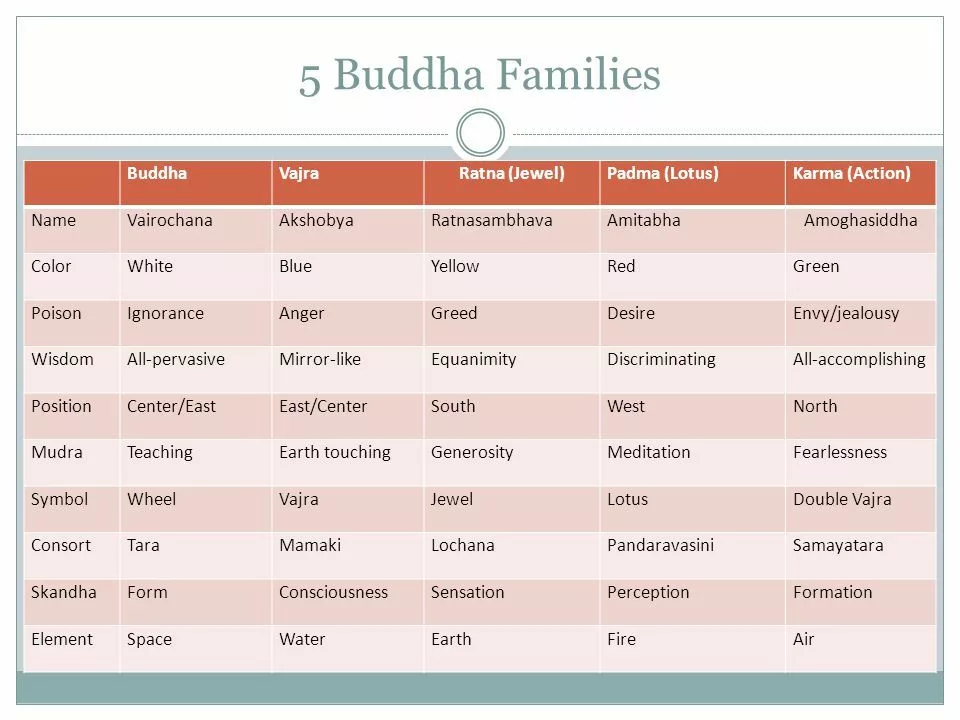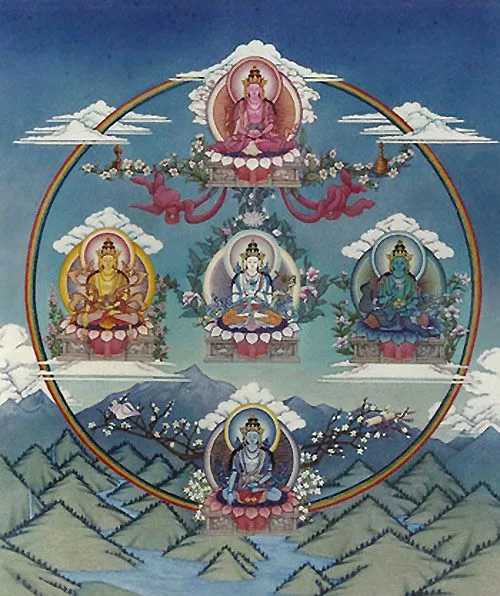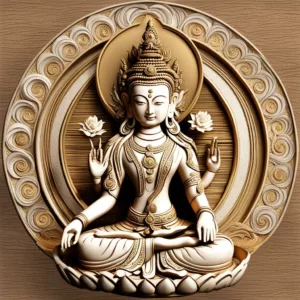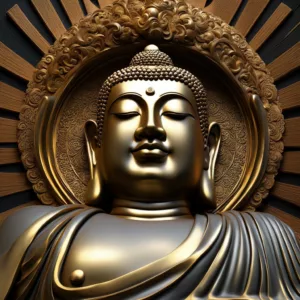Table of Contents
the 5 Buddha Families and 5 Wisdoms

The 5 Buddha families and the 5 Wisdoms are core Tantric Buddhist philosophies, providing a framework for understanding the diverse aspects of human nature and the path to spiritual growth. This article will delve into these concepts, their significance, and how they are represented in Buddhist art and practice.
I, like many practitioners, like to chat about our 5 families style. I used to be more ‘karma,’ highly active and ambitious. Now I find myself a bit more mellow, but overly analytical. This is a vajra mindset. What style are you?
The 5 Buddha Families
The 5 Buddha families, also known as the Five Dhyani Buddhas or the Five Wisdom Buddhas, represent various aspects of the enlightened consciousness. Each Buddha family is associated with a particular direction, color, wisdom, and a delusion that humans must overcome. The five families are:
- Amitabha: Symbolizes the transformation of desire into discernment. Its color is red, and it is associated with the West.
- Akshobhya: Represents the transformation of anger into mirror-like wisdom. Its color is blue, and it is associated with the East.
- Amoghasiddhi: Embodies the transformation of jealousy into all-accomplishing wisdom. Its color is green, and it is associated with the North.
- Ratnasambhava: Symbolizes the transformation of pride into equanimity. Its color is yellow, and it is associated with the South.
- Vairocana: Represents the transformation of ignorance into the wisdom of reality. Its color is white, and it is associated with the Center.
5 Buddha Families Chart
A chart of the 5 Buddha families can help visualize the relationships between the Buddhas, their wisdoms, and the delusions they help overcome. The chart typically presents the Buddhas in a circle, with Vairocana at the center, surrounded by the other four Buddhas in their respective directions. Each Buddha is depicted in their associated color, along with symbols representing their wisdom and the delusion they transform.

5 Buddha Families Mandala
The 5 Buddha families are often depicted in a mandala, a symbolic representation of the universe in Buddhist and Hindu art. The mandala serves as a spiritual tool for meditation and contemplation. In a 5 Buddha families mandala, each Buddha is placed in their respective direction, with Vairocana at the center. The mandala is filled with intricate designs and symbols that represent the wisdoms and delusions associated with each Buddha.

The 5 Wisdoms and Colors
The 5 Wisdoms are the enlightened qualities that each Buddha family represents. They are the positive counterparts to the delusions that humans must overcome on their path to enlightenment. The Wisdoms and their associated colors are:
- Discerning Wisdom (Red): This wisdom, represented by Amitabha, transforms desire into discernment.
- Mirror-like Wisdom (Blue): This wisdom, represented by Akshobhya, transforms anger into a clear, reflective state of mind.
- All-accomplishing Wisdom (Green): This wisdom, represented by Amoghasiddhi, transforms jealousy into the ability to accomplish all things.
- Equanimity Wisdom (Yellow): This wisdom, represented by Ratnasambhava, transforms pride into a state of even-mindedness and equanimity.
- Reality Wisdom (White): This wisdom, represented by Vairocana, transforms ignorance into an understanding of reality as it is.
The 5 wisdoms and colors are also associated with the 4 karmas or Buddha Activities.
Conclusion
The 5 Buddha families and the 5 Wisdoms provide a profound framework for understanding human nature and the path to enlightenment in Buddhism. They represent the transformation of our delusions into enlightened qualities, guiding us towards a deeper understanding of ourselves and the universe. Whether visualized in a chart or a mandala, these concepts serve as powerful tools for meditation and spiritual growth.
By understanding these concepts, we can better navigate our spiritual journey, transforming our negative tendencies into wisdom and compassion. As we delve deeper into the teachings of the Buddha families and the Wisdoms, we can find a path towards inner peace and enlightenment.

May all beings be happy
May all beings be peaceful
May all beings be safe
May all beings awaken to the light of their true nature
May all beings be free








